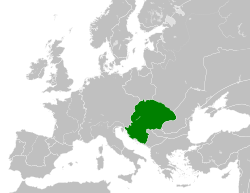Macaristan Krallığı
| 1000–1918[a]
1920–1946 | |||||||||||||||||||||
Millî marş Macarca: Himnusz (1844–1946) "Hymn" Royal anthem God save, God protect Our Emperor, Our Country! (1797–1918) | |||||||||||||||||||||
| Başkent | Budapeşte
Tarihi başkentler: | ||||||||||||||||||||
| Resmî dil(ler) | Diğer konuşulan diller: Carpathian Romani, Hırvatça, Lehçe, Rumence, Rutence, Sırpça, Slovakça, Slovence, Yidiş | ||||||||||||||||||||
| Resmî din | Katoliklik (Latin and Doğu Katolik),[2] Kalvinizm, Lütercilik, Doğu Ortodoksluk, Üniteryenizm, Yahudilik | ||||||||||||||||||||
| Hükûmet | Feudal monarchy (1000–1301) Absolute monarchy (1301–1868) Unitary parliamentary constitutional monarchy (1848–1918; 1920–46) | ||||||||||||||||||||
| Hükümdar | |||||||||||||||||||||
| |||||||||||||||||||||
| Palatine | |||||||||||||||||||||
| |||||||||||||||||||||
| Prime Minister | |||||||||||||||||||||
| |||||||||||||||||||||
| Yasama organı | Diet (from the 1290s) | ||||||||||||||||||||
| Tarihî dönem | 2nd millennium | ||||||||||||||||||||
| |||||||||||||||||||||
| Yüzölçümü | |||||||||||||||||||||
| 1200[3] | 282870 km2 | ||||||||||||||||||||
| 1910[4] | 282,870 km2 | ||||||||||||||||||||
| 1930[5] | 93,073 km2 | ||||||||||||||||||||
| 1941[6] | 172,149 km2 | ||||||||||||||||||||
| Nüfus | |||||||||||||||||||||
| |||||||||||||||||||||
| Para birimi | |||||||||||||||||||||
Macaristan Krallığı, Orta Çağ'dan 20. yüzyıla kadar yaklaşık bin yıl boyunca Orta Avrupa'da varlığını sürdüren bir monarşiydi. Macaristan Prensliği, ilk kral I. István'ın 1000 yılı civarında Estergon'da taç giymesi üzerine bir Hıristiyan krallığı olarak ortaya çıktı;[8] ailesi (Árpád Hanedanı) 300 yıl boyunca monarşiyi yönetti. 12. yüzyıla gelindiğinde krallık Avrupalı bir güç haline geldi.[8]
Ayrıca bakınız[değiştir | kaynağı değiştir]
Notlar[değiştir | kaynağı değiştir]
- ^ After the death of the Hungarian king at Battle of Mohács in 1526, Hungarian noble groups elected two kings dividing Hungary in two: Royal Hungary and Eastern Hungarian Kingdom. During the Ottoman occupation between 1541 and 1699, the Kingdom of Hungary was divided into three separate parts:
- Royal Hungary 1526–1699
- Eastern Hungarian Kingdom 1526–1570 which became the Principality of Transylvania 1570–1711
- Ottoman Hungary 1541–1699
Kaynakça[değiştir | kaynağı değiştir]
- Özel
- ^ Adeleye, Gabriel G. (1999). World Dictionary of Foreign Expressions. Ed. Thomas J. Sienkewicz and James T. McDonough, Jr. Wauconda, IL: Bolchazy-Carducci Publishers, Inc. 0-86516-422-3.
- ^ The majority of Hungarian people became Christian in the 10th century. Hungary's first king, Saint Stephen I, took up Western Christianity. Hungary remained solely Catholic until the Reformation took place during the 16th century and, as a result, Lutheranism and then, soon afterwards, Calvinism started to spread.
- ^ J. C. Russell, "Population in Europe 500–1500," in The Fontana Economic History of Europe: The Middle Ages, ed. Carlo M. Cipolla (London: Collins/Fontana Books, 1972), p. 25.
- ^ Emil Valkovics:Demography of contemporary Hungarian society 1 Mayıs 2016[Tarih uyuşmuyor] tarihinde Wayback Machine sitesinde arşivlendi., 1996, p. 15
- ^ Kollega Tarsoly, István, (Ed.) (1996). "Magyarország". Révai nagy lexikona (Macarca). 21. Budapeşte: Hasonmás Kiadó. s. 572. ISBN 963-9015-02-4.
- ^ Élesztős László, (Ed.) (2004). "Magyarország". Révai új lexikona (Macarca). 13. Budapeşte: Hasonmás Kiadó. ss. 882, 895. ISBN 963-9556-13-0.
- ^ Historical World Atlas. With the commendation of the Royal Geographical Society. Carthographia, Budapest, Hungary, 2005. 963-352-002-9
- ^ a b Kristó Gyula – Barta János – Gergely Jenő: Magyarország története előidőktől 2000-ig (History of Hungary from the prehistory to 2000), Pannonica Kiadó, Budapest, 2002, 963-9252-56-5, pp. 37, 113, 678 ("Magyarország a 12. század második felére jelentős európai tényezővé, középhatalommá vált."/"By the 12th century Hungary became an important European factor, became a middle power.", "A Nyugat részévé vált Magyarország.../Hungary became part of the West"), pp. 616–644
- Genel
- Wettig, Gerhard (2008), Stalin and the Cold War in Europe, Rowman & Littlefield, ISBN 978-0-7425-5542-6
Konuyla ilgili yayınlar[değiştir | kaynağı değiştir]
- Engel, Pál. The Realm of St Stephen: A History of Medieval Hungary, 895–1526. (2001).
- Frucht, Richard. Encyclopedia of Eastern Europe: From the Congress of Vienna to the Fall of Communism. 18 Mart 2010[Tarih uyuşmuyor] tarihinde Wayback Machine sitesinde arşivlendi. (2000).
- Hoensch, Jörg K., and Kim Traynor. History of Modern Hungary[ölü/kırık bağlantı], 1867–1994 (1996)
- Hanak, Peter et al. A History of Hungary (1994)
 "Hungary". Encyclopædia Britannica. 13 (11. bas.). 1911. ss. 894–931.
"Hungary". Encyclopædia Britannica. 13 (11. bas.). 1911. ss. 894–931.- Kings and Saints – The Age of the Árpáds (PDF). Budapest, Székesfehérvár: Institute of Hungarian Research. 2022. ISBN 978-615-6117-65-6.
- Kontler, Laszlo. A History of Hungary (2006) excerpt and text search
- Molnár, Miklós, and Anna Magyar. A Concise History of Hungary (2001) excerpt and text search
- Palffy, Geza. The Kingdom of Hungary and the Habsburg Monarchy in the Sixteenth Century (East European Monographs, distributed by Columbia University Press, 2010) 406 pages; Covers the period after the battle of Mohacs in 1526 when the Kingdom of Hungary was partitioned in three, with one segment going to the Habsburgs.
| Wikimedia Commons'ta Macaristan Krallığı ile ilgili ortam dosyaları bulunmaktadır. |
| Macaristan tarihi |
|---|
 |




